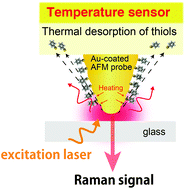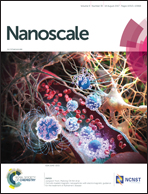Damage-free tip-enhanced Raman spectroscopy for heat-sensitive materials†
Abstract
We report a method to establish experimental conditions for tip-enhanced Raman spectroscopy (TERS) with low thermal and mechanical damage to samples. In this method, we monitor the thermal desorption of thiol molecules from a gold-coated probe of an atomic force microscope (AFM) via TERS spectra. Temperatures for desorption of thiol molecules (60–100 °C) from gold surfaces cover the temperature range for degradation of heat-sensitive biomaterials (e.g. proteins). By monitoring the desorption of the thiols on the probe, we can estimate the power of an excitation laser for the samples to reach their critical temperatures for thermal degradation. Furthermore, we also found that an active oscillation of AFM cantilevers significantly promotes the heat transfer from the probe to the surrounding medium. This enables us to employ a higher power density of the excitation laser, resulting in a stronger Raman signal compared with the signal obtained with a contact mode. We propose that this combinatory method is effective in acquiring strong TERS signals while suppressing thermal and mechanical damage to soft and heat-sensitive samples.



 Please wait while we load your content...
Please wait while we load your content...